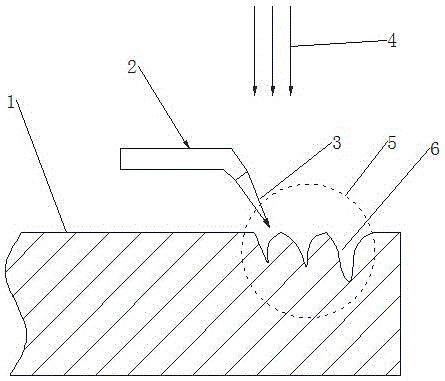Cavitation repair method for blades of water turbine
A blade cavitation and repair method technology, applied in the field of remanufacturing, can solve the problems of reducing blade strength, increasing repair workload, large blade deformation, etc., to achieve the effect of increasing service life and reducing repair workload
- Summary
- Abstract
- Description
- Claims
- Application Information
AI Technical Summary
Problems solved by technology
Method used
Image
Examples
Embodiment Construction
[0013] Such as figure 1 , 2 Shown, a kind of water turbine blade cavitation repairing method of the present invention comprises the following steps:
[0014] (1) Cleaning: Use an organic solvent to clean the blade 1 to be repaired, and remove the oil stain on the cavitation part of the blade 1 to be repaired;
[0015] (2) Rust removal: irradiate the cavitation area 5 with a high-power short-pulse laser beam 4 to vaporize and evaporate the metal oxide layer on the surface of the blade 1 until the body material of the blade 1 is exposed;
[0016] (3) Preheating: irradiate the part to be repaired with a high-power short-pulse laser beam, so that the material of the blade body that is about to be laser-melted will be melted in a shallow layer;
[0017] (4) Laser cladding: The cladding laser head sprays and fills the cladding metal powder to the preheated cavitation part, and emits a laser beam to irradiate the metal powder to fuse the cladding material and the blade body materia...
PUM
 Login to View More
Login to View More Abstract
Description
Claims
Application Information
 Login to View More
Login to View More - R&D
- Intellectual Property
- Life Sciences
- Materials
- Tech Scout
- Unparalleled Data Quality
- Higher Quality Content
- 60% Fewer Hallucinations
Browse by: Latest US Patents, China's latest patents, Technical Efficacy Thesaurus, Application Domain, Technology Topic, Popular Technical Reports.
© 2025 PatSnap. All rights reserved.Legal|Privacy policy|Modern Slavery Act Transparency Statement|Sitemap|About US| Contact US: help@patsnap.com


